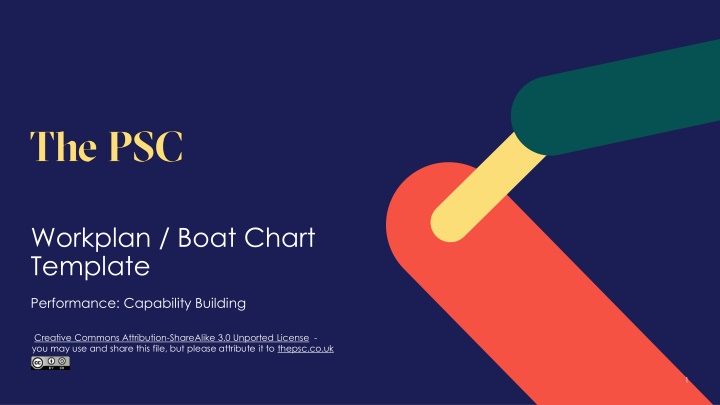Boat Chart Workplan for Project Management
Boat Chart Workplan is a visual representation of project phases, key activities, meetings, and duration. It provides a structured approach for complex projects without clear solutions, aiding in decision-making, option development, and reviews. The template allows easy customization and alignment of text and SmartArt objects. Helpful tips include keeping the plan simple, using issue tree and prioritization matrix, and utilizing the tool for achieving project objectives efficiently.
Download Presentation

Please find below an Image/Link to download the presentation.
The content on the website is provided AS IS for your information and personal use only. It may not be sold, licensed, or shared on other websites without obtaining consent from the author.If you encounter any issues during the download, it is possible that the publisher has removed the file from their server.
You are allowed to download the files provided on this website for personal or commercial use, subject to the condition that they are used lawfully. All files are the property of their respective owners.
The content on the website is provided AS IS for your information and personal use only. It may not be sold, licensed, or shared on other websites without obtaining consent from the author.
E N D
Presentation Transcript
Workplan / Boat Chart Template Performance: Capability Building Creative Commons Attribution-ShareAlike 3.0 Unported License - you may use and share this file, but please attribute it to thepsc.co.uk 1
Boat Chart project work plan(template) <Month> x x x x <phase 1> <phase 2> <phase> <phase> Estimated Duration X weeks X weeks X weeks X weeks Key activities x x x x Key meetings x x x x End products x x x x Creative Commons Attribution-ShareAlike 3.0 Unported License - you may use and share this file, but please attribute it to thepsc.co.uk 2
Boat Chart project work plan(example) September October November January December Diagnosis and Option Development Option Development and Review Report & Syndicate findings Set-Up Estimated Duration 1-2 weeks ~1.5 months ~1 month 2-3 weeks Key activities Understand context Establish team working relationships Identify key stakeholders Put in data requests Set up interviews / fieldwork Conduct interviews with key stakeholder groups (see separate slide for initial list) Gather data and patient MI Determine analytical priorities and conduct analyses Syndicate and review findings Conduct follow-up interviews as appropriate Share recommendations Work with Steering Group to: Influence key decision- makers Develop outline action plan for implementation Key meetings First Steering Group meeting Kick off working team meeting Workshop to test and improve initial findings (October 21) Steering Group (first week of November) Workshop to develop options (early November) Steering Groups (first week December) Final Steering Group (last week December) Workshop to syndicate and improve options and recommendations (second week December) End products List of interviewees / fieldwork Interview guides Data request Initial findings report diagnosing strategic challenges Emerging recommendations report, including: Interim list of options, with associated financial impact SWOT analysis / risk assessment of delivering each option Final report Creative Commons Attribution-ShareAlike 3.0 Unported License - you may use and share this file, but please attribute it to thepsc.co.uk 3
How to use a boat chart workplan(from our FEP & PSAT programmes) What is this tool? A boat chart * is a very simple style of work plan showing end products, key activities and meetings, and the overall timing of each project phase PowerPoint instructions This boat chart * was created by combining a table (to make the text align nicely) with PPT s SmartArt illustration feature (look it up on the web to find out more) This template uses the basic chevron process SmartArt layout. You can either copy across the table and SmartArt object to your own presentation, or insert a table and SmartArt object directly When you click on the chevrons (the boats ), a text box will appear to the left where you can easily edit text and use ENTER to create new chevrons Also, when you click on the chevrons, the two Smart Art tools tabs will appear in the ribbon so you can format and design it as you wish When to use this tool? It is useful for projects involving complex problems without clear solutions, where the detailed path of the project is not evident at the outset (e.g., decision-making, option generation, reviews) Tips for workplanning Keep it simple: The purpose is to help the team achieve the project objectives on-time and in-full (running the work plan is not an objective in itself) Remember to use your issue tree and prioritisation matrix to identify and select the workstreams which go into your work plan The work plan often ends up being used primarily as a tool for communicating with stakeholders so make sure it is easily understandable (avoid jargon and acronyms) and fits on a single page You can resize the whole object using the outer box You can also double ungroup to convert The table can be sized and adapted the distribute columns option in the table layout tab is useful for aligning columns with the chevrons Find videos and more tools and templates at: thepsc.co.uk/capability-building/ * boat chart is from the way the chevrons look like a line of boats following each other Creative Commons Attribution-ShareAlike 3.0 Unported License - you may use and share this file, but please attribute it to thepsc.co.uk 4























